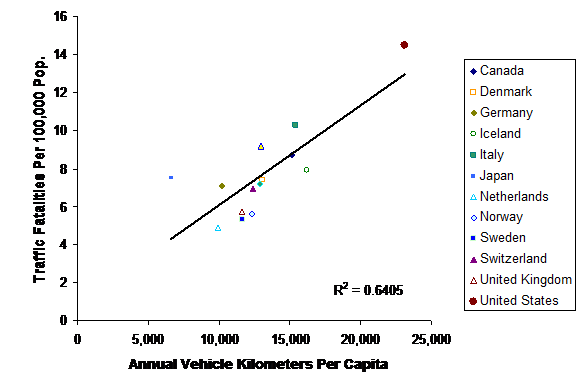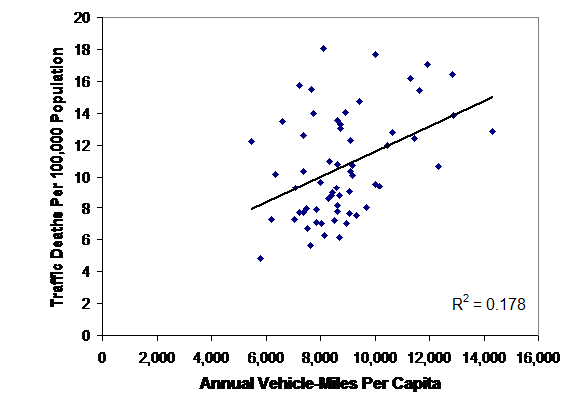Automobile travel imposes significant health risks. Traffic fatality rates, obesity and related illnesses such as diabetes, and total air pollution emissions tend to increase with per capita annual vehicle mileage.
Automobile travel imposes significant health risks. Traffic fatality rates, obesity and related illnesses such as diabetes, and total air pollution emissions tend to increase with per capita annual vehicle mileage. These risks help explain why United States residents have significantly shorter life spans than peer countries: average longevity is almost 1.5 years below the OECD average, despite spending about 2.5 times as much per capita on healthcare.
That sounds pretty negative so let's rephrase that statement: transport and land use policy reforms can provide substantial health benefits by creating communities where residents drive less and rely more on alternative modes. The public health community is starting to recognize this (APHA 2010; CDC 2010), but there is still plenty of confusion. Many experts fail to apply comprehensive analysis when evaluating healthy community planning strategies.
A key principle of good planning is that analysis should be comprehensive and integrated. You can call it sustainability or multi-objective, or integrated planning, but regardless of name it means that we consider all significant objectives, options and impacts when evaluating possible solutions to specific problems. This is in contrast to reductionist planning, in which agencies have narrowly defined goals and responsibilities, and so can rationally implementing solutions to the problems within their responsibility which exacerbate other problems facing society, and it undervalues strategies that provide modest but multiple benefits.
Let's apply this perspective to critique a recent report, Transportation and Health: Policy Interventions for Safer, Healthier People and Communities, by the Partnership for Prevention, which includes the U.S. Center for Disease Control and Prevention, the Safe Transportation Research and Education Center at the University of California at Berkeley, and the engineering firm Booz Allen Hamilton.
This report identifies transport policies that can improve public health by reducing vehicle emissions, increasing physical activity, and reducing traffic crashes. It attempts to be comprehensive (good). It evaluates a wide range of solutions (good), including TDM and smart growth policies (very good), but only considers them as emission reduction strategies; there is no recognition that reducing vehicle travel can also increase traffic safety (very bad).
This is a major omission. Transportation Demand Management (TDM, also called mobility management and VMT reduction strategies) and smart growth are among the most cost effective ways to increase public safety and health (Litman and Fitzroy 2010; Lucy 2003). For example, a few years ago, researchers Ewing, Schieber and Zegeer categorized 280 U.S. counties according to their sprawl index, which measures various land use factors such as density, mix and centricity. They found that the ten smartest growth counties have less than a quarter the average per capita traffic fatality rate as the ten most sprawled counties, as illustrated below in Figure 1. This is a huge benefit which many households care about, yet smart growth policies are primarily promoted as a way to reduce infrastructure costs or achieve environmental objectives, we fail to also promote it as a way to create safer communities.
Figure 1 Annual Traffic Death Rate (Ewing, Schieber and Zegeer 2003)
 The smartest growth counties have a quarter the per capita traffic fatality rate as the most sprawled counties.
The smartest growth counties have a quarter the per capita traffic fatality rate as the most sprawled counties.
Similarly, transportation pricing reforms, such as more efficient pricing for roads, parking, vehicle insurance and fuel, can provide substantial crash reductions, in addition to other economic, social and environmental benefits, yet their safety benefits are generally overlooked.
Figure 2 Vehicle Mileage and Traffic Fatality Rates (OECD Data)
This international comparision shows that per capita traffic fatality rates increase with annual vehicle travel.
Figure 2 shows a strong positive relationship between per capita vehicle travel and fatality rates among OECD (Organization for Economic Cooperation and Development) countries. Similarly, Figure 3 shows a positive correlation between vehicle travel and traffic fatalities for U.S. cities.
Figure 3 Vehicle Mileage and Traffic Fatality Rates For U.S. Cities (FHWA Data)

This comparision of U.S. cities shows that per capita traffic fatality rates increase with annual vehicle travel.
As a result, transportation policy reforms that reduce vehicle travel can provide signficant safety benefits. For example, Grabowski and Morrisey (2004 and 2006) estimate that each 10% U.S. fuel price increase reduces total traffic deaths 2.3%, and each one-cent increase in state gasoline taxes will yield a 0.25% decrease in per capita traffic fatalities and a 0.26% decrease in fatalities per VMT. Leigh and Geraghty (2008) estimate that a sustained 20% gasoline price increase would reduce approximately 2,000 traffic crash deaths (about 5% of the total), plus about 600 air pollution deaths. Other transport pricing reforms, including efficient parking pricing (motorists pay directly for using parking spaces), Pay-As-You-Drive (PAYD) vehicle insurance (insurance premiums are based directly on annual vehicle mileage), and congestion pricing (tolls imposed on congested roads) probably provide similar or even greater safety benefits.
The Partnership for Prevention report emphasizes the conventional narrative that traditional traffic safety programs are successful, because it measures risk per mile rather than per capita. It states that during the last four decades, "the number of fatalities and injuries per mile driven dropped by nearly 80 percent, a truly dramatic achievement," without mentioning that the U.S. has the highest per capita traffic fatality rate among peer countries. As a result of this myopia the report only recommends traffic safety strategies that reduce per-mile crash rates, it ignores traffic safety strategies that reduce per capita mileage such as TDM and smart growth.
This is important because TDM and smart growth face significant obstacles. For example, PAYD vehicle insurance is an effective demand management strategy, and because it gives higher risk motorists a greater financial incentive to reduce their mileage, it can provide extra traffic safety benefits, yet currently only one North American insurance company, MileMeter, offers fully-marginal PAYD. Similarly, smart growth policies must overcome resistance by entrenched interests, such as the National Association of Home Builders, as discussed in my recent column, An Inaccurate Attack On Smart Growth.
More comprehensive analysis helps identify integrated solutions that are truly best overall, considering all benefits and costs. It can also identify opportunities for cooperation among diverse interests. For example, if we recognize that transportation pricing reforms can reduce traffic congestion, infrastructure costs, accidents, obesity, pollution emissions and sprawl, we can build a coalition among transportation agencies, business groups, public health officials and environmentalists. Similarly, recognizing the full health and safety benefits of more compact development can increase political support for smart growth policies.
I believe that the root of many contemporary problems is a failure to apply comprehensive, integrated planning analysis. I would expect public health professionals to be among the first to appreciate its value, so I am surprised that the Partnership for Prevention failed to apply it in this major, recent study.
References and Information Resources
APHA (2010), The Hidden Health Costs of Transportation: Backgrounder, American Public Health Association (www.apha.org); at www.apha.org/advocacy/reports/reports.
J. Ball, M. Ward, L. Thornley and R. Quigley (2009), Applying Health Impact Assessment To Land Transport Planning, Research Report 375, New Zealand Transport Agency (www.ltsa.govt.nz); at www.ltsa.govt.nz/research/reports/375.pdf.
Judith Bell and Larry Cohen (2009), The Transportation Prescription: Bold New Ideas for Healthy, Equitable Transportation Reform in America, PolicyLink and the Prevention Institute Convergence Partnership (www.convergencepartnership.org/transportationhealthandequity).
CDC (2010), CDC Transportation Recommendations, Center for Disease Control and Prevention (www.cdc.gov/transportation/default.htm).
Reid Ewing, et al. (2003), "Relationship Between Urban Sprawl and Physical Activity, Obesity, and Morbidity," American Journal of Health Promotion, Vol. 18, No. 1 (www.healthpromotionjournal.com), Sept/Oct. 2003, pp. 47-57, at www.smartgrowth.umd.edu/pdf/JournalArticle.pdf.
Billie Giles-Corti, Sarah Foster, Trevor Shilton and Ryan Falconer (2010), "The Co-benefits for Health of Investing in Active Transportation," NSW Public Health Bulletin, Vol. 21, No5–6, pp. 122-127; at www.ncbi.nlm.nih.gov/pubmed/20637168.
David C. Grabowski and Michael A. Morrisey (2004), "Gasoline Prices and Motor Vehicle Fatalities," Journal of Policy Analysis and Management (www.appam.org/publications/jpam/about.asp), Vol. 23, No. 3, pp. 575–593.
David C. Grabowski and Michael A. Morrisey (2006), Do Higher Gasoline Taxes Save Lives?" Economics Letters (www.elsevier.com/locate/econbase), Vol. 90, pp. 51–55.
Sonja Kahlmeier, Francesca Racioppi, Nick Cavill, Harry Rutter, and Pekka Oja (2010), "‘Health in All Policies' in Practice: Guidance and Tools to Quantifying the Health Effects of Cycling and Walking," Journal of Physical Activity and Health, Vol. 7, Supplement 1, pp. S120-S125; at www.euro.who.int/document/E93592.pdf.
J. Paul Leigh and Estella M. Geraghty (2008), "High Gasoline Prices and Mortality From Motor Vehicle Crashes and Air Pollution," Journal of Occupational and Environmental Medicine, Vol. 50, Is. 3, March, pp. 249-54; at www.ncbi.nlm.nih.gov/pubmed/18332774.
Todd Litman (2004), If Health Matters: Integrating Public Health Objectives into Transportation Decision-Making, Victoria Transport Policy Institute (www.vtpi.org); at www.vtpi.org/health.pdf; previously published as, "Integrating Public Health Objectives in Transportation Decision-Making," American Journal of Health Promotion, Vol. 18, No. 1 (www.healthpromotionjournal.com), Sept./Oct. 2003, pp. 103-108; at www.vtpi.org/AJHP-litman.pdf.
Todd Litman (2011), Pricing For Traffic Safety: How Efficient Transport Pricing Can Reduce Roadway Crash Risk, Victoria Transport Policy Institute (www.vtpi.org); at www.vtpi.org/price_safe.pdf.
Todd Litman and Steven Fitzroy (2010), Safe Travels: Evaluating Mobility Management Traffic Safety Benefits, Victoria Transport Policy Institute (www.vtpi.org); at www.vtpi.org/safetrav.pdf.
William H. Lucy (2003), "Mortality Risk Associated With Leaving Home: Recognizing the Relevance of the Built Environment," American Journal of Public Health, Vol 93, No. 9, September, pp. 1564-1569; at www.ajph.org/cgi/content/full/93/9/1564.
NCBW (2010), Increasing Physical Activity Through Community Design: A Guide for Public Health Practitioners, National Center for Bicycling and Walking (www.bikewalk.org); at www.bikewalk.org/pdfs/2010/IPA_full.pdf.
PfP (2011), Transportation and Health: Policy Interventions for Safer, Healthier People and Communities, Partnership for Prevention (Safe Transportation Research and Education Center, Booz Allen Hamilton, and the Centers for Disease Control and Prevention) (www.prevent.org); at www.prevent.org/Additional-Pages/Transportation-and-Health.aspx.

Planetizen Federal Action Tracker
A weekly monitor of how Trump’s orders and actions are impacting planners and planning in America.

Map: Where Senate Republicans Want to Sell Your Public Lands
For public land advocates, the Senate Republicans’ proposal to sell millions of acres of public land in the West is “the biggest fight of their careers.”

Restaurant Patios Were a Pandemic Win — Why Were They so Hard to Keep?
Social distancing requirements and changes in travel patterns prompted cities to pilot new uses for street and sidewalk space. Then it got complicated.

Platform Pilsner: Vancouver Transit Agency Releases... a Beer?
TransLink will receive a portion of every sale of the four-pack.

Toronto Weighs Cheaper Transit, Parking Hikes for Major Events
Special event rates would take effect during large festivals, sports games and concerts to ‘discourage driving, manage congestion and free up space for transit.”

Berlin to Consider Car-Free Zone Larger Than Manhattan
The area bound by the 22-mile Ringbahn would still allow 12 uses of a private automobile per year per person, and several other exemptions.
Urban Design for Planners 1: Software Tools
This six-course series explores essential urban design concepts using open source software and equips planners with the tools they need to participate fully in the urban design process.
Planning for Universal Design
Learn the tools for implementing Universal Design in planning regulations.
Heyer Gruel & Associates PA
JM Goldson LLC
Custer County Colorado
City of Camden Redevelopment Agency
City of Astoria
Transportation Research & Education Center (TREC) at Portland State University
Camden Redevelopment Agency
City of Claremont
Municipality of Princeton (NJ)





























